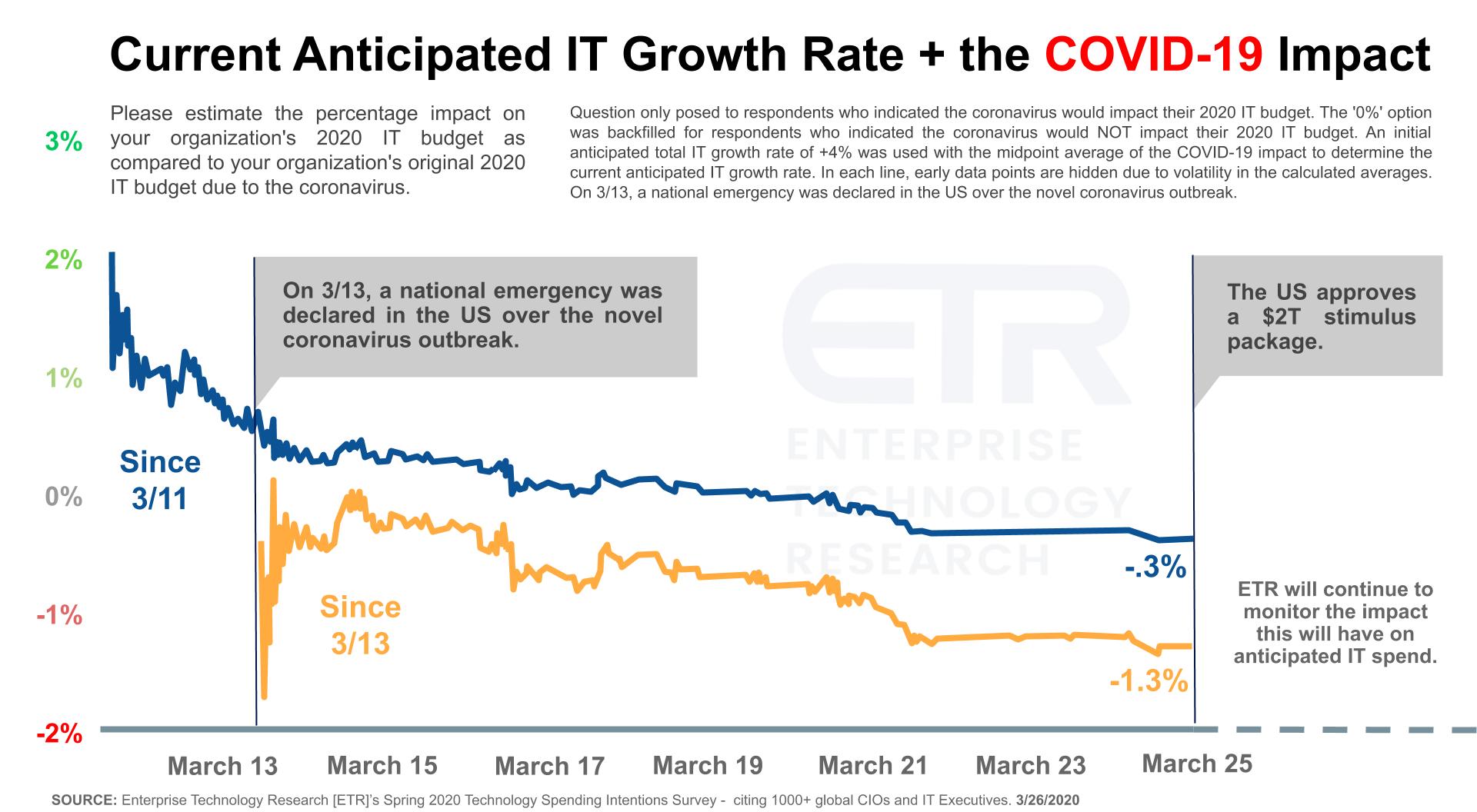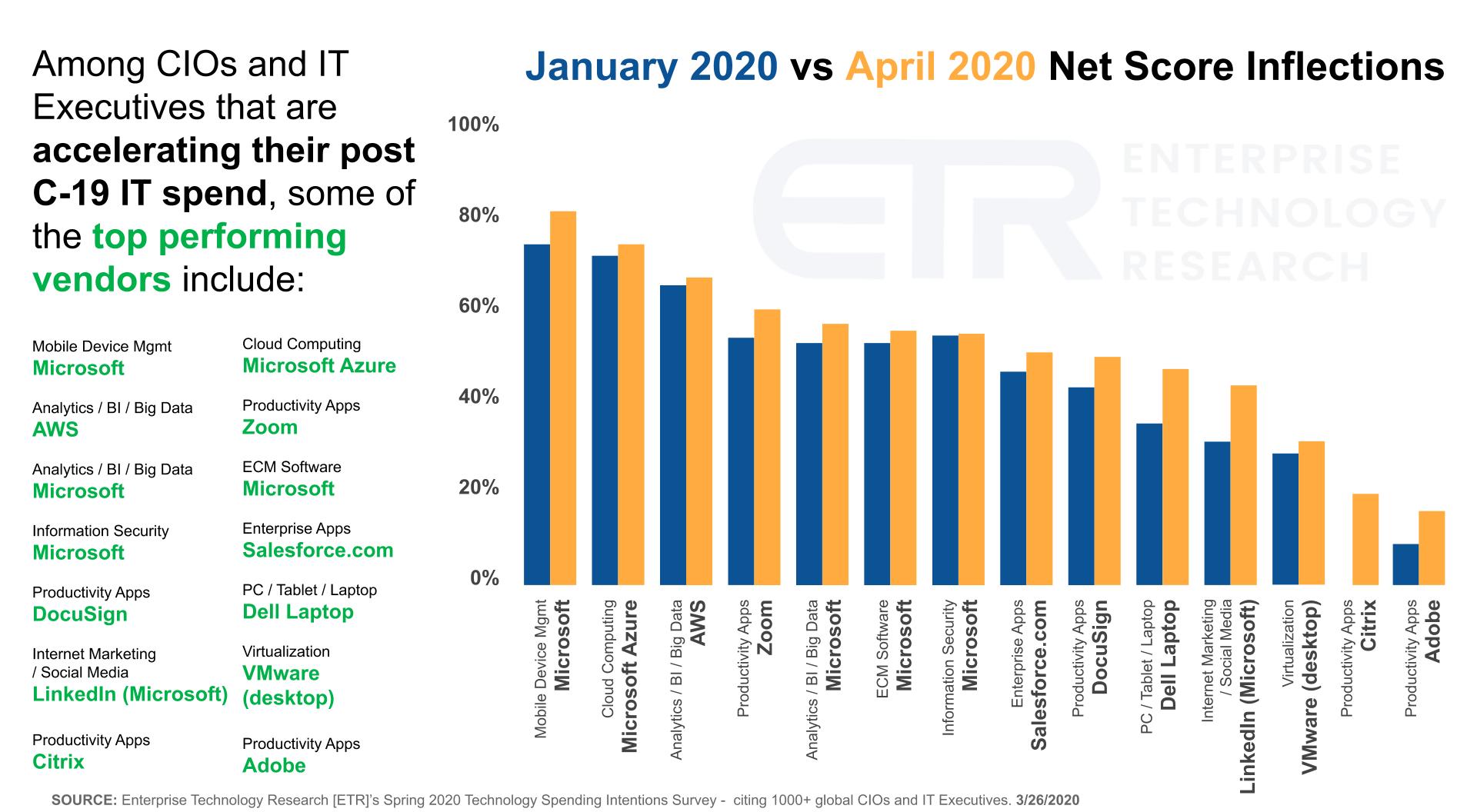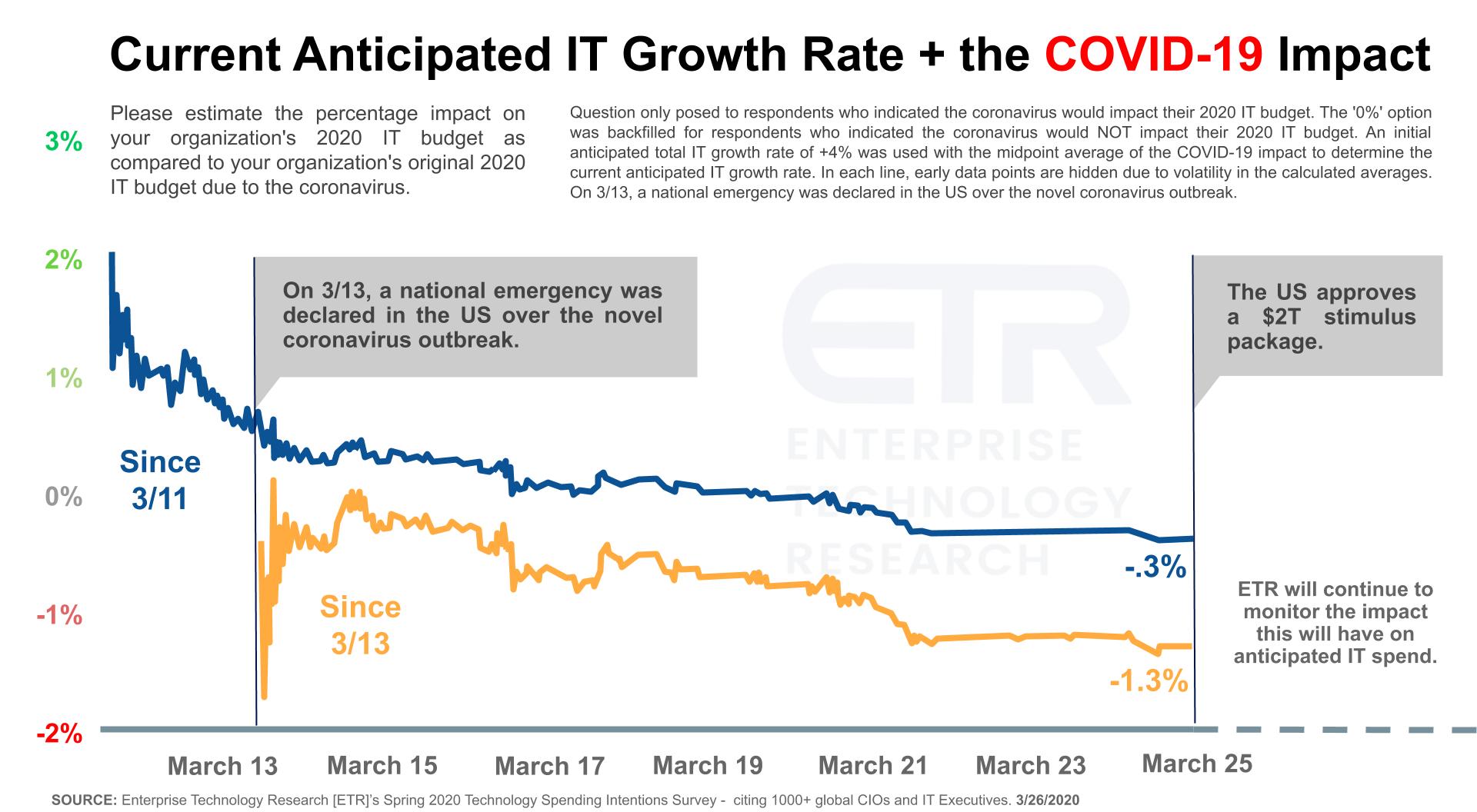 INFRA
INFRA
 INFRA
INFRA
 INFRA
INFRA
As the COVID-19 pandemic spreads, the outlook for spending on information technology is getting worse and likely will fall into negative territory this year despite a boost from work-at-home technologies.
That’s the upshot from the latest survey results from Enterprise Technology Research. Last week, we reported ETR results from over 1,000 chief information officers and IT practitioners, and made a call that surprisingly, a large number of respondents – about 40% – indicated they didn’t expect a change in their 2020 IT spending. At the same time, about 20% of the survey said they’re going to spend more in 2020, largely related to work from home or WFH infrastructure.
ETR was the first to report this offset from WFH. Notably, the spending wasn’t just collaboration tools and video conferencing software. It was infrastructure around that, including security, network bandwidth, desktop virtualization and other types of infrastructure to help workers increase their productivity.
The market research firm made the call that it looked like budgets were going to be flat for 2020. You also might recall consensus estimates for 2020 came into the year at about 4%, slightly ahead of GDP.
Obviously, all that has changed. Last week, ETR took the forecast down to flat spending for 2020 and now this week we’ve gone slightly negative for the year.

As we reported last week, the ETR surveys have run through the bulk of March. More than 1,000 CIOs and IT buyers had weighed in at that time and the number is now approaching an N of 1,300. We will keep you updated on new survey results as we assess the COVID-19 IT spending impact.

The chart above shows the change in CIOs response over time to question as to how COVID-19 will likely impact their spending in 2020. As you can see, sentiment dropped steadily after the declaration of a national emergence in the U.S (blue line). The yellow line adjusts the data and calibrates to isolate on those responses after 3/13.
We brought in Sagar Kadakia, ETR’s director of research, to explain this dynamic further and assess theCOVID-19 IT spending impact. Here’s what he told us:
The last time we spoke, we were around an N or sample size of about 1000. And we were right around that zero percent growth rate. One of the unique things that we’ve done is we’ve left this survey open. So what that allows us to do is really track the impact on annual IT growth, essentially daily. As things have progressed, as you look at that blue line, you can really see the growth rate has continued to trend downwards. And as of just a day or two ago, we’re now below zero. And so I think because of what’s occurring right now, the overall current climate continues to slightly deteriorate.
You can see on March 13, a national emergency was declared and that’s really when the blue line started to decline. By resetting the data on the yellow line, and accounting only for those responses after the event, we can get a better picture of what’s actually happening in the market.
The next event we’re tracking is the sentiment after the passage of the aid package that should be approved by the House of Representatives today. This will help us further assess the COVID-19 IT spending impact.
Kadakia further explained the ETR methodology:
If you look at that yellow line again, effectively what you’re seeing is, we remove the first six or seven hundred respondents that took the survey prior to 3/13 when the US declared a national emergency. We can recalculate the growth rate. And we can see it’s around… It’s almost down 1.5%. So the beauty of doing this, really polling daily, is it allows us to be just as dynamic, as many of the organizations we survey. Remember, many CIOs report that these budget changes are going to be temporary. Organizations are figuring out what they’re doing day by day. And a lot of that is dictated based on government actions. And so uniquely here, what we’re able to do is kind of give people a range and also say, “based on these events, this is how things are changing”
Let’s dig into the data a bit more and look at the range of expectations for 2020 IT spending.

The chart above shows the latest data from the ETR survey. Last week, the gray line (no change) was at 40% so now down slightly. A full 22% of respondents expect increased spending which is up slightly from last week. Most of the increases are in the lower range – 1% to 10% — whereas the left side is more pronounced and negative – in other words, those expecting declines and the degree of reduction.
To summarize the key points:
According to Kadakia, ETR’s research shows that healthcare, pharma, industry materials, manufacturing and retail organizations indicate the highest levels of broken supply chains today. The expectation is that three months from now, it’s actually going to worsen.
As we discussed last week, we don’t expect a V-shaped recovery. Things are not likely to improve in the next few weeks or even the next month or two. CIOs are indicating that they expect conditions to worsen in the supply chain side and on the demand side, the industries getting hit the hardest are retail, consumer, airline and certain delivery services. These sectors also expect demand to worsen in the near term.
Some additional thoughts on industry change:
One of the dynamics we discussed with Kadakia is that unlike other downturns (for example, 2000 and 2008) a primary focus today is on maintaining productivity, rather than cutting costs. We’re not saying that companies aren’t being prudent with expenses – they are – but the crisis is bringing in forced cost reductions such as travel bans and cancelled events. The companies that have survived and possess strong balance sheets are trying to maintain their employees and get the most from at home workers.
This creates a two-sided dynamic. ETR data shows that the big cloud providers are showing momentum. Semiconductor companies look to be surprising on the upside as Micron just reported yesterday citing strong demand in both cloud and data center. The point is CEOs have not capitulated to the crisis – at least thus far.
Let’s look at some of the vendor and sector data. Over the next several weeks we’ll be digging deeply into this and updating you regularly.
In the chart below, we’re showing fourteen companies from the survey showing higher Net Scores in the April Survey relative to January. Remember, Net Score is a measure of spending momentum.

Some of the sectors we’re calling out that have momentum right now include:
WFH infrastructures are getting more spend for the vendors that are best positioned. Kadakia explained the above chart:
What you’re looking at here is isolated to all of those organizations and customers that indicated that they’re increasing their budgets because of COVID-19, specifically related to work from home infrastructure. And what we’re doing is then isolating vendors that are getting the most upticks in spend.
This really nicely aligns with a lot of the themes that we were talking about collaboration tools. You see that VMware, they’re all right on the virtualization side, MDM with Microsoft. And you’re seeing a lot of other vendors with Citrix and Zoom and Adobe. These are the ones that we think are going to benefit from this kind of Work From home infrastructure movement. It’s not just the qualitative and the commentary. This is all analytics, we really went in and analyzed every single one of these organizations that were increasing their budgets and tried to pinpoint using different data analysis techniques, and to see which vendors were really getting the majority or the largest, pie of that spend.
Recently we interviewed Sanjay Poonen, chief operating officer of VMware. He was cautious in two respects: 1) He did not want VMware to appear to be “chasing the ambulance;” and 2) He was notably sanguine about VMware’s future prospects but sensibly careful about being too optimistic in the near term. Nonetheless, VMware’s desktop virtualization and security business should be well-positioned. [Note: Like many other major tech players, VMware has suspended forward earnings guidance.]
Similarly, Michael Dell was recently quoted in CRN discussing Dell Technologies’ supply chain and in particular its ability to meet laptop demand as WFH needs surge. However, the on-prem businesses for both VMware and Dell are likely to come under pressure in the near term.
This trend is not isolated to Dell. Cisco is another example of a company that will likely see bifurcated demand – i.e. a tailwind for WFH from Webex and Meraki with headwinds for on-prem,
As we’ve pointed out previously, in the past two years, organizations have experimented with digital transformations and are beginning to double down and operationalize these initiatives. As such they’ve done two things:
As we’ve also discussed, the cloud has continued its steady march, eating into on-premises infrastructure and software companies’ momentum. Although the on-prem giants all have cloud plays, some are better positioned than others. For example, while we like Palo Alto Networks’ long-term prospects, the company has struggled with its cloud execution.
Others such as NetApp have embraced the cloud but their exposure to legacy on-prem declines is substantial. Teradata similarly is being hit by cloud-native analytic database growth from the likes of Snowflake and Amazon Web Services’ RedShift.
IBM’s large services business as well as Oracle’s large on-prem software estate are exposed. The flip side is both companies have a cloud play and though not as competitive in IaaS with AWS, Microsoft Azure and Google, their respective software-as-a-service businesses somewhat insulate them from earnings disasters.
Symantec, Check Point Software and MicroStrategy are others that ETR surveys show are currently exposed.
As Kadakia said:
There’s no reprieve for these legacy names and we don’t anticipate them getting additional spend from the WFH infrastructure movement.
The key point here is that in difficult times, people will often revert to the “safe bet” and that can benefit legacy names. But it’s very possible that dynamic won’t fully play out this time.
The bottom line is this is a “tale of two cities.” It’s not an across-the-board down or up scenario. You have to dig into the data by vendor by segment by vertical to get a full picture.
Our next goal with ETR is to determine whether or not the stimulus/aid package is having an impact on how people are responding. As well, we want to continue to track sentiment based on Coronavirus news as it relates to how they’re changing their budgets.

Kadakia told us that he’s watching, over the next four or five days, for an uptick in the lines here. Organizations are wrapping their heads around the federal government’s actions. Although there is a roadmap in place to help us get out of this, if the news gets worse – which is likely, the lines will continue to come down.
The combination of actions by the Fed, who continue to have a number of arrows in their quiver and the U.S. federal government are key to understanding the COVID-19 IT spending impact. However, other central banks, especially in Europe, may not have as much flexibility. The market shook off the more than 3 million jobless number yesterday, but the impact of that carnage will likely be reflected in the market over the coming months.
The market is still functioning poorly. Despite the actions in monetary and fiscal policy, oil prices as we mentioned last week, are a big a concern. Jobless claims topping 3 million are believed to be as high as 5 million based on analysis of Google searches by two prominent economists. What’s even more concerning is the shocking forecast that experts estimate we could lose 14 million jobs by this summer.
Here’s the full video analysis:
A note: We’re on it
As we’ve said, it’s an uncertain and dynamic picture, so we’ll continue to forecast as accurately as possible and we’ll forecast often.
We told you last week that theCUBE skeleton crews are in the studio and we’re keeping the content flowing. Most on our team are working from home but are still on the grid. Currently, our Palo Alto studio is fully operational for four days each week capturing remote guests on camera and tying into our Boston studio operation. So get in touch if you need anything: We are here to help.
You have our commitment that theCUBE and ETR will keep you up to date on the COVID-19 IT spending impact. ETR survey data keeps rolling in – you can get updates on its Web site, since ETR is on this trend more than any other data firm we know.
Remember, these episodes are all available as podcasts wherever you listen. I’m available at david.vellante@siliconangle.com, @dvellante on Twitter, or via comments on our linkedin posts.
You may want to check out this ETR Tutorial we created, which explains the spending methodology in more detail.
Wishing good health and safety for you and your families.
Support our mission to keep content open and free by engaging with theCUBE community. Join theCUBE’s Alumni Trust Network, where technology leaders connect, share intelligence and create opportunities.
Founded by tech visionaries John Furrier and Dave Vellante, SiliconANGLE Media has built a dynamic ecosystem of industry-leading digital media brands that reach 15+ million elite tech professionals. Our new proprietary theCUBE AI Video Cloud is breaking ground in audience interaction, leveraging theCUBEai.com neural network to help technology companies make data-driven decisions and stay at the forefront of industry conversations.